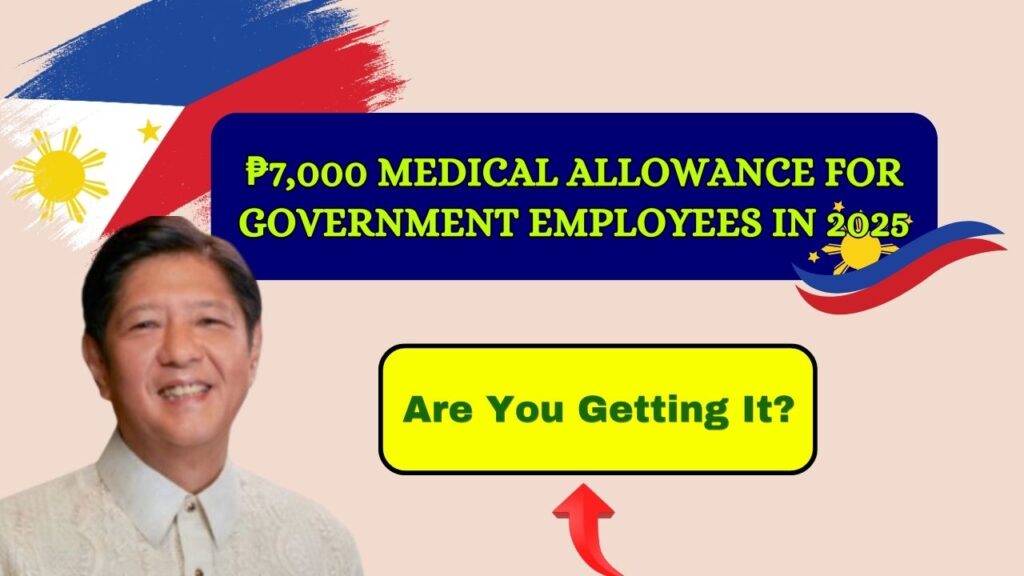₱7,000 Medical Allowance for Government Employees in 2025 – Are You Getting It?
₱7,000 Medical Allowance for Government Employees in 2025 – If you’re a government employee in the Philippines, there’s good news! A new initiative is rolling out in 2025, offering a ₱7,000 medical allowance to help cover healthcare expenses. But are you eligible? How can you claim it? And what does it actually cover?

Let’s break it down in simple terms so every government worker — from teachers and clerks to LGU staff — understands how to benefit from this important support.
₱7,000 Medical Allowance for Government Employees in 2025
| Feature | Details |
|---|---|
| Benefit | ₱7,000 medical allowance per year |
| Year of Implementation | 2025 |
| Eligible Recipients | Regular, contractual, and part-time civilian government employees |
| Exclusions | Uniformed personnel, GOCCs under RA 10149, employees with existing HMO benefits, etc. |
| Modes of Payment | HMO-type plan or reimbursement for medical expenses |
| Coverage | Hospitalization, diagnostic tests, medicines, and emergency care |
| Source | DBM Budget Circular No. 2024-6 |
| Official Announcement | Executive Order No. 64 (PCO) |
The ₱7,000 medical allowance for government employees in 2025 is a timely and much-needed step to support public servants’ health and well-being. It reflects the government’s acknowledgment of healthcare challenges faced by employees — especially those without HMO coverage or in remote areas.
If you’re a qualified public worker, don’t let this benefit go to waste. Reach out to your HR, understand your agency’s disbursement method, and start preparing to claim your rightful healthcare support.
What Is the ₱7,000 Medical Allowance in 2025?
The ₱7,000 medical allowance is a newly approved healthcare subsidy for civilian government employees in the Philippines. This benefit is intended to help cover health-related costs such as HMO premiums, hospitalization, medicines, and diagnostic procedures.
It was made official through Executive Order No. 64 and further clarified in Budget Circular No. 2024-6, both released in April 2024.
This initiative recognizes the rising cost of healthcare and aims to reduce the financial burden on public servants while promoting access to quality medical services.
Why Was This Allowance Introduced?
Public employees, especially those without private HMO coverage, often shoulder significant medical costs. The government acknowledged this need and responded with the ₱7,000 yearly allowance to support:
- Out-of-pocket expenses
- Preventive healthcare
- Emergency treatments
- Geographically isolated workers with no access to HMOs
It’s part of the government’s ongoing effort to improve employee welfare and healthcare access across all public sectors.
Who Is Eligible for the ₱7,000 Medical Allowance?
According to the Department of Budget and Management (DBM), eligible beneficiaries include:
Included:
- Employees of national government agencies (NGAs)
- State universities and colleges (SUCs)
- Government-owned and controlled corporations (GOCCs) not covered by RA No. 10149 and EO No. 150
- Local Government Units (LGUs)
- Local Water Districts
- Those with regular, casual, or contractual appointments
- Elective and appointive civilian officials
You are eligible whether you’re working full-time or part-time.
Who Is NOT Eligible?
Not everyone in the government service is covered. The following groups are excluded:
Not Covered
- Military and uniformed personnel (PNP, AFP, BFP, BJMP)
- GOCC employees governed under RA No. 10149 or EO No. 150
- Employees already receiving HMO-type coverage through special laws or agency programs
- Staff of Congress, Judiciary, and other agencies with fiscal autonomy
- Workers hired under job orders, contracts of service, or as consultants, apprentices, and student laborers
If you’re unsure where you fall, consult your agency’s HR department for clarification.
How Will the ₱7,000 Be Given?
The allowance is not directly handed out as cash in every case. Instead, it can be received through two main channels:
1. HMO-Type Health Package
- Agencies can purchase HMO-style plans for their employees.
- These cover check-ups, labs, emergency services, and more.
- This is ideal for employees in urban centers with access to HMOs.
2. Cash Reimbursement
- For those in rural or remote areas, cash reimbursement of up to ₱7,000 is allowed.
- You must present proof of medical expenses (e.g., hospital bills, prescriptions).
- This ensures fair access for all employees regardless of location.
Agencies are instructed to prioritize flexibility, especially for those in Geographically Isolated and Disadvantaged Areas (GIDA).
Where Can You Use the Allowance?
Eligible medical expenses include:
- Hospitalization costs
- Emergency treatments
- Outpatient consultations
- Diagnostic exams (X-rays, MRIs, blood tests)
- Prescription medications
- Medical and surgical procedures
However, cosmetic or elective procedures not related to health treatment may be excluded. Always check guidelines from your HR or finance unit before making a claim.
Real-Life Example: Abra LGU Implementation
In early 2025, the Province of Abra confirmed that it had already distributed the ₱7,000 medical allowance to its permanent employees, as per DBM instructions. This rollout demonstrated that LGUs were given funding support and clear mechanisms to implement the program.
If your local agency hasn’t disbursed yet, you’re encouraged to follow up or coordinate with HR to ensure you’re included.
How to Claim Your ₱7,000 Medical Allowance?
Follow these simple steps to make sure you get your medical benefit:
Step 1: Confirm Eligibility
Talk to your agency’s Human Resources or Personnel Office to check your qualification.
Step 2: Choose the Mode
Ask whether your agency offers:
- An HMO package, or
- A reimbursement scheme
Step 3: Submit Documents (if reimbursing)
Provide:
- Official receipts or medical bills
- Doctor’s prescriptions or hospital discharge summaries
- Statement of account if hospitalized
Step 4: Wait for Approval
The agency’s accounting or finance unit will verify the documents and process the reimbursement or provide the health plan details.
Tips for Maximizing the Medical Allowance
- Keep digital copies of all receipts for easy submission.
- Inquire early in the year about claiming procedures to avoid deadlines.
- If your agency offers HMO plans, compare coverage options to choose what fits your medical needs best.
- For frequent medication purchases, ask your doctor for prescriptions in bulk where allowed.
What If My Agency Hasn’t Implemented It Yet?
While many government units have started implementing the program, some may still be working through internal processes. If your agency hasn’t initiated disbursement:
- Inquire with your HR officer or Finance Department
- Reference Budget Circular 2024-6 to advocate for timely implementation
- Consider submitting a written request or formal query through your department head
SSS Benefit Increases Announced – Check If You’re One of the Qualified Members!
SSS Partial Disability Payments 2025: Eligibility Criteria and Benefit Amounts
Philippines Boosts Pension to ₱1,000 for Indigent Seniors in 2025—Are You on the List?
FAQs About ₱7,000 Medical Allowance for Government Employees in 2025
Q1. Will this ₱7,000 be added to my salary?
No. It’s not part of your salary. It’s a health benefit to be availed either through a health plan or medical expense reimbursement.
Q2. Is this a one-time benefit?
It is annual, starting from FY 2025. Future years will depend on budget allocations.
Q3. Can I use this for my family’s medical bills?
No. It’s strictly for the employee’s own medical expenses unless your agency provides extended benefits through an HMO plan.
Q4. What if I only spend ₱3,000? Can I save the rest?
Unused amounts do not carry over. Only actual expenses up to ₱7,000 are reimbursed or covered.
Q5. How long does reimbursement take?
Processing depends on your agency’s accounting procedures, but guidelines instruct efficient disbursement to avoid delays.
Q6. Can retirees avail of this benefit?
Currently, this benefit is limited to active employees. Retired personnel are not covered unless re-employed under qualifying terms.







